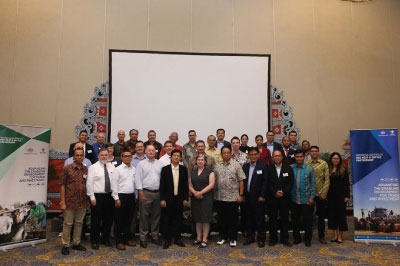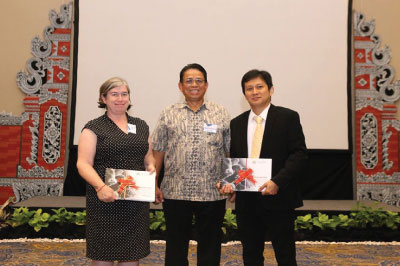Meeting Inspires Action, Innovation
Tangible action plans and pathways to the digital economy were core agenda items at the eighth meeting of the Partnership, held in Bali, Indonesia in early November.
As the Partnership entered its second phase during 2019, its goals for developing the red meat and cattle sector became even more ambitious.
This robust attitude was reflected at the eighth meeting of the Partnership, where a progressive and proactive mood was evident among key members, government officials and industry observers.
Co-Chairs Mr Wisnu Wijaya Soedibjo and Ms Jodie McAlister underlined the importance of the meeting to develop clear guidance on the Partnership’s future activities and to advance the industry’s participation in digital environments.
Mr Soedibjo highlighted the vital role of the five industry-led reference groups that were established following recommendations in the program design document for the Partnership’s second phase.
“This meeting promotes direct engagement between reference group members to clearly identify the Partnership’s future priorities,” Mr Soedibjo said.
“It also encourages dialogue between industry and government representatives of our two countries on how we can respond to digital transformation in the sector.”
Ms McAlister, meanwhile, placed the Partnership’s 2019 achievements in the context of its broader objectives.
“This year alone, the Partnership has trained over 117 Indonesians in commercial cattle breeding and management, and has produced software and tools to help potential investors plan for entering the cattle business,” Ms McAlister said.
“This is an important milestone to help accelerate the commercial viability of the cattle breeding business in Indonesia.”
Breeding Models are Commercially Viable, Study Says

One of flagship Partnership’s programs is promoting the commercial cattle breeding business in Indonesia by piloting three breeding models. Since 2016, the Partnership supported studies to assess the commercial viability of the three breeding models tested under the IACCB Program.
Mr Paul Boon, IACCB Strategic Program Advisor, presented the outcomes of this assessment at the eighth meeting of the Partnership.
Highlights from the assessment of the three models are:
Integrated cattle and palm oil production (SISKA) is a promising model with an internal rate of return (IRR) of 10% to 16%. The model also has a positive cashflow starting from the fourth year.
The open grazing model requires low initial investment and operational costs, but achieving the necessary growth rates of cattle requires development of improved pastures. This model has an IRR of 10% and is producing feeder cattle (cattle of about 320 kilograms as imported from Australia) at lowest cost ($3.20 per kilogram).
The smallholder breedlot or cut-and-carry model provides excellent results for calving and weaning rates, promising IRR of 12%, and positive cashflow by the third year.
However, there are major risks around the communal systems and technical challenges associated with this model, including cohesion of the farmer groups or cooperatives, access to finance to ensure continuity in feed supply and maintaining the condition of the herd throughout the dry season.
Partnership Co-Chair Mr Wisnu Wijaya Soedibjo was pleased that, after three years engagement with the IACCB Program, Indonesia has three breeding system choices, all of which can potentially be profitable.
“We must now find ways to promote these commercial opportunities in cattle breeding and encourage expansion of the industry through investment,” Mr Soedibjo said.
For more information on each breeding model, visit iaccbp.org
Groups Get to Work on Action Plans

The Partnership’s program design document, which was completed and endorsed in the first half of 2019, sets the strategic direction for the second phase of collaboration between Indonesia and Australia in the red meat and cattle sector.
Among the key recommendations in the document was the establishment of industry reference groups, led by specialists in each priority area, to help create clear priorities for the Partnership’s endeavours.
The five reference groups that have since been created are • Investment • Supply Chain • Innovation and Exports • Capacity Building • Communications.
At the eighth meeting of the Partnership, each reference group engaged in detailed dialogue to identify their key priorities and develop tangible action plans.
Among the many and varied commitments set down for the first half of 2020, the Investment reference group will develop clearly defined marketing materials for potential investors, including realistic commercial barriers, opportunities and risk ratings.
The Supply Chain group will review all supply chain research and actively oversee the Indonesia-Australia Commercial Cattle Breeding (IACCB) Program to ensure it delivers desired outcomes in its final year.
The Innovation and Export group will focus on product integrity and marketing, where quick wins could be realised. It will initiate a study to increase yields from current production and determine a shortlist of products that can help bolster Indonesia’s exporting efforts.
The Capacity Building group will review past and present training programs, including those delivered in Vietnam, then determine the need for more targeted training courses.
Among other tasks, the Communications group will review and refine the Partnership’s communications strategy to reach more targeted audience groups and stakeholders in Indonesia and Australia in promoting Partnership’s objectives.
Digital Thinking to Shape Future Efforts

Delegates to the eighth meeting of the Partnership were asked to consider how the red meat and cattle sector might adapt and evolve to take full advantage of the emerging digital economy.
To inspire lateral thinking, delegates heard from two prominent experts on the future of the sector.
The first speaker was Mr Juan Permata Adoe, Indonesian Partnership member and Deputy Chairman of the Food and Cattle Industry division of the Indonesian Chamber of Commerce and Industry (KADIN).
Mr Adoe presented KADIN’s Industrial Study for the Formulation of Beef Commodity and Cattle Cultivation. The study presents a comprehensive approach to developing Indonesia’s red meat and cattle markets, including strategies to promote greater per capita consumption of beef in the country.
The second speaker was Mr Pamitra Wineka, the president and co-founder of TaniGroup, a start-up company working on the agriculture supply chain, e-commerce and crowdfunding.
Mr Wineka provided an overview of digital technologies in the Indonesian agriculture sector, their success and challenges, as well as future trends.
Attendees then discussed how digital technologies are changing the way the sector operates, how the Australian and Indonesian industries are responding to those changes, and how the Partnership can promote innovation within the sector.
Following these deliberations, the Partnership’s Innovation and Exports reference group recognised the need to review the sector’s existing digital capacities and initiate a scoping study of digital technologies that could be used to drive industry growth.
For the official communique of the eighth Partnership meeting, visit redmeatcattlepartnership.org/partnership-meeting









